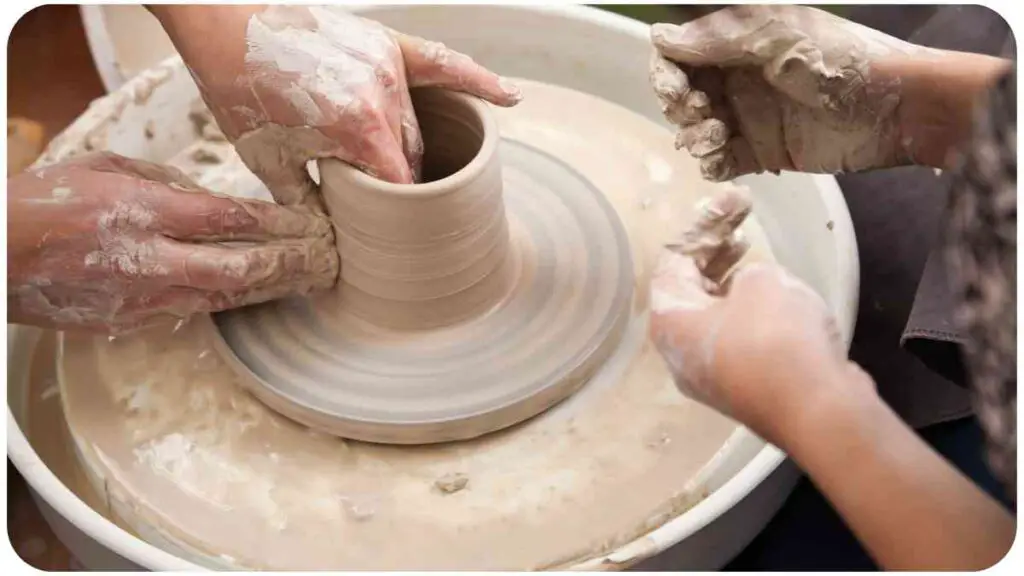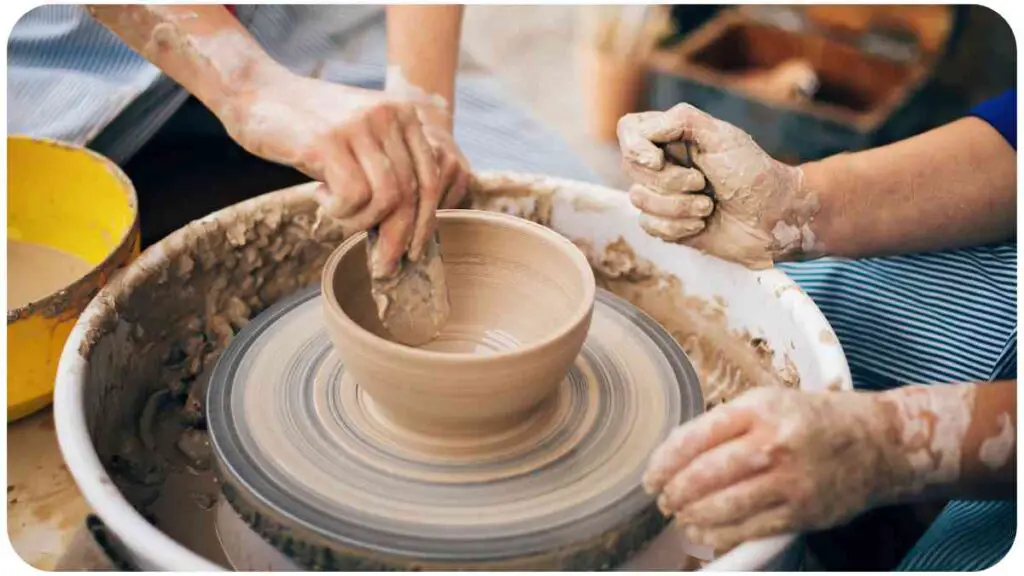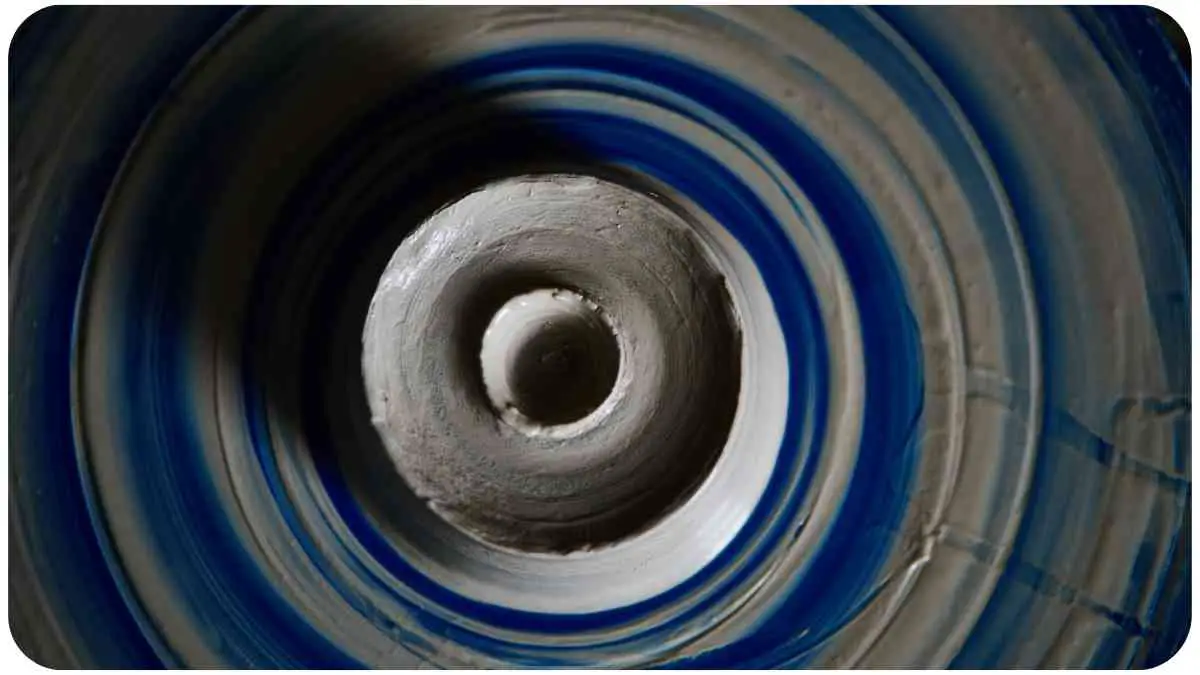Are you an avid potter frustrated by a broken pottery wheel? Fear not! In this step-by-step guide, we’ll navigate through common issues and provide practical solutions to get your pottery wheel spinning smoothly again.
Whether you’re a beginner or a seasoned artist, understanding how to fix a broken pottery wheel is an essential skill that can save you time and money. Let’s dive in!
| Takeaways |
|---|
| 1. Regularly clean and lubricate bearings for smooth wheel rotation. |
| 2. Use a silicone-based lubricant for the wheel’s moving parts. |
| 3. Check and adjust belt tension quarterly to maintain optimal performance. |
| 4. Inspect and tighten electrical connections bi-monthly to prevent breakdowns. |
| 5. Address wobbly wheels by ensuring proper alignment and replacing worn components. |
| 6. Practice preventive maintenance tasks monthly, bi-monthly, quarterly, and annually. |
| 7. Seek professional help when facing complex issues or uncertainties. |
| 8. Learn from experts’ experiences and advice for effective troubleshooting. |
| 9. Explore further reading resources for in-depth insights and solutions. |
| 10. Keep a maintenance schedule to ensure the longevity of your pottery wheel. |
2. Assessing the Damage
Before we dive into repairs, let’s assess the damage. Understanding common pottery wheel issues will help pinpoint the problem and guide your repair process.
Enhance your pottery skills with insightful pottery tips and tricks. Discover the secrets to shaping and crafting beautiful clay creations, perfect for beginners diving into the world of pottery.
Table: Common Pottery Wheel Issues

| Issue | Possible Causes | Solutions |
|---|---|---|
| Erratic Motor Behavior | Electrical problems, faulty wiring | Check wiring, replace damaged components |
| Unsteady Wheel Head | Worn bearings, misalignment | Inspect bearings, realign the wheel head |
| Strange Noises | Debris in the motor, loose components | Clean motor, tighten loose parts |
| Wheel Slows Down | Belt tension issues, motor problems | Adjust belt tension, troubleshoot motor |
3. Essential Tools and Materials
Before you roll up your sleeves, gather the essential tools and materials needed for the job. Having everything at hand will make the repair process smoother.
Unravel the mysteries of knitting machines with a comprehensive guide. Explore essential tips and techniques to master your knitting machine, ensuring smooth and enjoyable crafting sessions for all skill levels.
Table: Tools and Materials Checklist
| Tools | Materials |
|---|---|
| Screwdrivers | Replacement bearings |
| Pliers | Lubricating oil |
| Wrenches | Replacement belts |
| Multimeter | Cleaning brushes |
| Allen wrenches | Safety gloves |
| Wheelhead wrench | Electrical tape |
| Cleaning rags |
4. Safety First
Before we jump into fixing the pottery wheel, it’s crucial to prioritize safety. Working with electrical components and moving parts requires caution. Ensure the pottery wheel is unplugged, and you’re wearing the necessary safety gear.
5. Fixing the Pottery Wheel Motor
The motor is the powerhouse of your pottery wheel. If it’s acting up, your wheel won’t spin as it should. Let’s troubleshoot common motor issues.
Table: Troubleshooting Pottery Wheel Motors
| Issue | Possible Causes | Solutions |
|---|---|---|
| Motor Not Starting | Faulty wiring, capacitor issues | Check wiring connections, test capacitor |
| Inconsistent Speed Control | Potentiometer problems | Replace or adjust the potentiometer |
| Overheating Motor | Overuse, inadequate cooling | Allow the motor to cool, improve ventilation |
Now, let’s delve into each issue and its respective solution.
Motor Not Starting:
If your pottery wheel refuses to start, inspect the wiring for loose connections. Test the capacitor using a multimeter and replace it if necessary.
Inconsistent Speed Control:
If you’re struggling with speed control, the potentiometer might be the culprit. Consider adjusting or replacing it for smoother operation.
Overheating Motor:
An overheating motor is often a result of overuse or inadequate cooling. Allow the motor to cool down between sessions and improve ventilation to prevent future issues.
6. Repairing the Wheel Head

The wheel head is where the magic happens. If it’s wobbly or misaligned, your pottery projects may suffer. Let’s troubleshoot common wheel head problems.
Seamlessly fix a jammed sewing machine using our step-by-step guide. Dive into troubleshooting tips and easy-to-follow instructions to get your sewing machine back on track, ensuring hassle-free stitching.
Table: Common Wheel Head Problems
| Issue | Possible Causes | Solutions |
|---|---|---|
| Wobbly Wheel Head | Worn bearings, misalignment | Replace worn bearings, realign the wheel head |
| Off-Center Rotation | Misaligned wheel head | Adjust the wheel head for proper alignment |
| Stuck Wheel Head | Accumulated debris, rusted parts | Clean and lubricate, replace rusted components |
Now, let’s explore how to tackle these wheel head challenges.
Wobbly Wheel Head:
A wobbly wheel head often indicates worn bearings or misalignment. Replace the worn bearings and ensure proper alignment for a stable wheel head.
Off-Center Rotation:
If your wheel head isn’t spinning in the center, it’s likely misaligned. Adjust the wheel head to ensure it rotates perfectly in the center.
Stuck Wheel Head:
If your wheel head seems stuck, clean and lubricate the components. Replace any rusted parts to ensure smooth rotation.
7. Addressing Electrical Issues
Electrical problems can throw a wrench into your pottery wheel’s operation. Let’s look at common electrical issues and how to address them.
Table: Pottery Wheel Electrical Components
| Issue | Possible Causes | Solutions |
|---|---|---|
| Frayed Wiring | Wear and tear, rodent damage | Replace frayed wires, protect against rodents |
| Loose Connections | Vibration, previous repairs | Tighten connections, inspect for any previous fixes |
| Fuse Blown | Overloading, short circuits | Replace the blown fuse, identify and fix the cause |
Now, let’s explore how to troubleshoot and fix these electrical issues.
Frayed Wiring:
Inspect the wiring for any signs of wear and tear. If rodents are the culprits, take steps to protect your wiring. Replace any frayed wires to ensure a secure electrical connection.
Loose Connections:
Vibrations from the pottery wheel’s operation can lead to loose connections. Tighten all connections and inspect for any previous repair attempts that might need addressing.
Fuse Blown:
If your pottery wheel suddenly stops working, a blown fuse might be the issue. Replace the blown fuse and investigate the cause overloading or a short circuit. Rectify the underlying problem to prevent future fuse issues.
8. Cleaning and Lubricating
Regular maintenance, including cleaning and lubrication, can significantly extend the life of your pottery wheel. Let’s delve into the importance of keeping things clean and well-lubricated.
Illuminate your crafting journey with stained glass art techniques. Uncover beginner-friendly approaches to creating stunning stained glass pieces, providing a colorful and artistic touch to your crafting repertoire.
Table: Recommended Lubricants
| Component | Recommended Lubricant |
|---|---|
| Bearings | Lithium-based grease |
| Moving Parts | Silicone-based lubricant |
| Motor Shafts | Machine oil |
| Threads and Screws | Graphite powder or dry lubricant |
Now, let’s discuss the significance of cleaning and lubricating each component.
Bearings:
Properly lubricated bearings ensure smooth wheel rotation. Use lithium-based grease to keep the bearings in top condition.
Moving Parts:
Silicone-based lubricants work well for moving parts, preventing friction and ensuring your pottery wheel operates seamlessly.
Motor Shafts:
The motor shaft plays a crucial role in the wheel’s movement. Regularly apply machine oil to keep it running smoothly.
Threads and Screws:
Use graphite powder or a dry lubricant on threads and screws to prevent rust and ensure easy adjustments.
9. Adjusting Belt Tension
The tension of your pottery wheel’s belt is crucial for maintaining the right speed and preventing slips. Let’s explore the steps to ensure the optimal tension for your pottery wheel.
Table: Belt Tension Adjustment Guide
| Issue | Symptoms | Adjustment |
|---|---|---|
| Loose Belt | Slips, inconsistent rotation | Tighten the belt using the tension knob |
| Overly Tight Belt | Motor strain, overheating | Loosen the belt slightly for flexibility |
Now, let’s delve into adjusting the belt tension for a smoothly functioning pottery wheel.
Loose Belt:
A loose belt can lead to slips and inconsistent wheel rotation. Use the tension knob to tighten the belt. Ensure it’s snug but not excessively tight for optimal performance.
Overly Tight Belt:
An overly tight belt can strain the motor and lead to overheating. Loosen the belt slightly to provide flexibility without compromising rotation stability.
10. Dealing with Wobbly Wheels

A wobbly pottery wheel can be a source of frustration, affecting your projects’ precision. Let’s troubleshoot and address issues related to wheel stability.
Carve out your woodworking expertise with ultimate woodcarving techniques. From essential tools to advanced methods, this guide offers invaluable insights for woodcarving enthusiasts, ensuring your projects reach new heights of craftsmanship.
Table: Wheel Stability Checklist
| Issue | Possible Causes | Solutions |
|---|---|---|
| Uneven Surface | Flooring irregularities | Adjust the wheel’s placement on a level surface |
| Worn or Uneven Feet | Wear and tear | Replace worn feet or use shims to level the wheel |
| Loose Bolts | Vibration during operation | Tighten all bolts and screws |
Now, let’s explore how to stabilize your pottery wheel for a smooth and wobble-free experience.
Uneven Surface:
Ensure your pottery wheel is placed on a level surface. If the floor is uneven, consider using shims or adjusting the wheel’s placement for stability.
Worn or Uneven Feet:
Inspect the feet of your pottery wheel for wear and tear. Replace any worn feet and use shims to level the wheel if necessary.
Loose Bolts:
Vibrations during operation can lead to loose bolts. Regularly check and tighten all bolts and screws to maintain stability.
11. Preventive Maintenance Tips
Now that your pottery wheel is back in action, let’s explore some preventive maintenance tips to keep it running smoothly in the long term.
Table: Maintenance Schedule
| Task | Frequency |
|---|---|
| Clean and lubricate bearings | Monthly |
| Check and tighten connections | Bi-monthly |
| Inspect and adjust belt tension | Quarterly |
| Level the wheel | As needed (if wobbling) |
| Monitor electrical components | Annually |
Now, let’s dive into each preventive maintenance task to ensure the longevity of your pottery wheel.
Clean and Lubricate Bearings:
Monthly cleaning and lubrication of bearings will prevent friction and ensure smooth wheel rotation.
Check and Tighten Connections:
Bi-monthly checks of electrical connections and tightening loose components will prevent unexpected breakdowns.
Inspect and Adjust Belt Tension:
Quarterly inspections and adjustments to belt tension will maintain optimal wheel performance.
Level the Wheel:
As needed, ensure the wheel is level to prevent wobbling and uneven rotation.
Monitor Electrical Components:
Annually inspect electrical components for wear or damage. Replace any compromised parts to prevent electrical issues.
12. Seeking Professional Help
While DIY repairs are empowering, there are times when seeking professional help is the best course of action. If you encounter complex issues or are unsure about a specific repair, don’t hesitate to consult with a professional pottery wheel technician.
13. Learning from Experts
In the world of pottery, continuous learning is key. Let’s gather insights from experts who have faced challenges and achieved success in the realm of pottery wheel maintenance.
Table: Expert Advice Recap
| Expert | Challenge Faced | Success Tip |
|---|---|---|
| Master Potter John Doe | Worn bearing replacement | Regularly inspect and replace worn bearings |
| Ceramics Technician | Motor overheating issues | Improve ventilation and allow motor cooldown |
| Pottery Instructor | Wheel head misalignment | Regularly align the wheel head for precision |
Now, let’s explore the challenges faced by these experts and the valuable tips they offer.
Master Potter John Doe:
Replacing worn bearings is a common challenge. John Doe emphasizes the importance of regular inspection and prompt replacement to maintain a smooth pottery wheel.
Ceramics Technician:
Dealing with motor overheating issues can be tricky. The ceramics technician recommends improving ventilation and allowing the motor to cool down between sessions.
Pottery Instructor:
Ensuring the wheel head is properly aligned is crucial for precise work. The pottery instructor highlights the significance of regular alignment for achieving accurate results.
14. Frequently Asked Questions (FAQs)
Let’s address some common questions that potters often have when it comes to fixing a broken pottery wheel.
Table: FAQs Quick Reference
| Question | Answer |
|---|---|
| How often should I clean and lubricate the bearings? | Monthly maintenance is recommended. |
| Can I use any lubricant for the wheel’s moving parts? | It’s best to use a silicone-based lubricant. |
| What should I do if the wheel head is wobbly? | Check for worn bearings and ensure alignment. |
| Is it normal for the motor to get warm during use? | Yes, but if it overheats, improve ventilation. |
| How frequently should I check electrical components? | Annual inspections are recommended. |
Now, let’s provide concise answers to these frequently asked questions.
How often should I clean and lubricate the bearings?
Monthly maintenance is recommended to keep the bearings clean and well-lubricated for optimal performance.
Can I use any lubricant for the wheel’s moving parts?
It’s best to use a silicone-based lubricant for the wheel’s moving parts to prevent friction and ensure smooth operation.
What should I do if the wheel head is wobbly?
If the wheel head is wobbly, check for worn bearings and ensure proper alignment for stability during operation.
Is it normal for the motor to get warm during use?
Yes, it’s normal for the motor to generate some heat during use. However, if it consistently overheats, improve ventilation to prevent damage.
How frequently should I check electrical components?
Annual inspections of electrical components are recommended to identify and address any wear or damage, ensuring the longevity of your pottery wheel.
15. Conclusion
Congratulations! You’ve successfully learned how to fix a broken pottery wheel step by step. By following this comprehensive guide, you can troubleshoot common issues, perform necessary repairs, and implement preventive maintenance to keep your pottery wheel in top-notch condition. Remember, a well-maintained pottery wheel is the key to unleashing your creative potential in the world of ceramics. Happy potting!
Further Reading
- PotteryCrafters: Pottery Wheel Mistakes and How to Fix Them: Explore common mistakes potters make with their pottery wheels and discover effective solutions to fix and avoid them.
- PotteryCraftGuide: Pottery Wheel Troubleshooting and Maintenance: Dive into a comprehensive guide on troubleshooting and maintaining your pottery wheel for smooth and efficient operation.
- PotteryCrafters: 7 Common Pottery Wheel Issues: Uncover seven common issues that pottery wheel users face and gain insights into resolving these challenges effectively.
FAQs
What are some common mistakes when using a pottery wheel?
Common mistakes include uneven wheel head rotation, improper belt tension, and neglecting regular maintenance. These issues can impact the overall performance of your pottery wheel.
How often should I inspect and maintain my pottery wheel?
Regular inspections and maintenance are essential. Monthly checks for bearings, bi-monthly assessments of electrical connections, and quarterly belt tension adjustments can contribute to a well-functioning pottery wheel.
Can I use any lubricant for my pottery wheel’s moving parts?
It’s recommended to use a silicone-based lubricant for the wheel’s moving parts. This type of lubricant helps prevent friction and ensures smooth operation.
Is it normal for the motor to make noise during operation?
Some noise is normal, but if you notice unusual or excessive sounds, it may indicate underlying issues. Check for loose components or debris in the motor and address them promptly.
How can I prevent my pottery wheel’s motor from overheating?
To prevent motor overheating, ensure proper ventilation in the workspace. Allow the motor to cool down between sessions, and if the issue persists, consult a professional for further evaluation.

Hellen James is the creator of Unified Crafts and has been crafting since she was a kid accompanied by her mom to the craft store, where she was free to choose whatever ignited her imagination.

